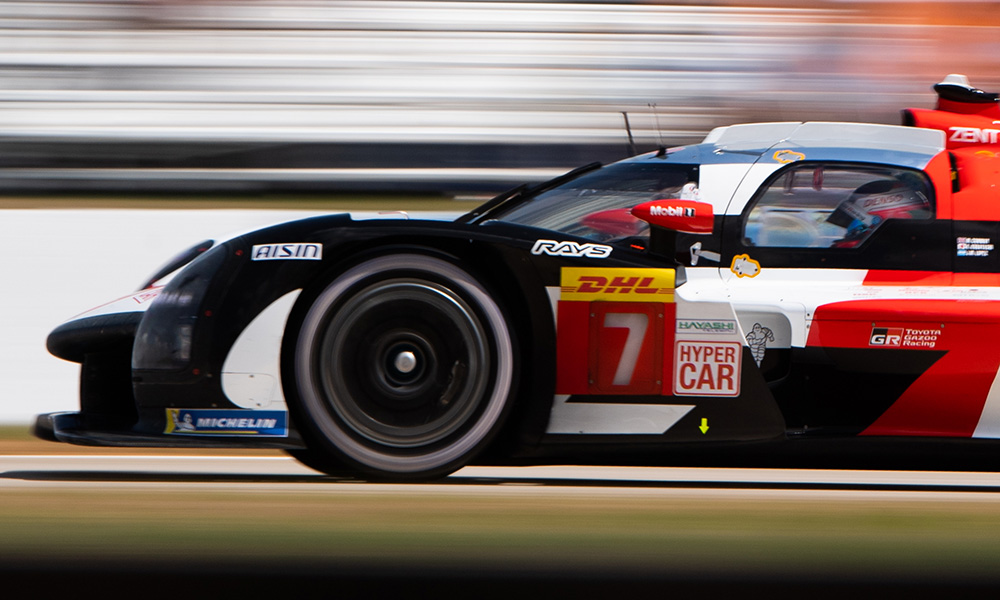
Photo: Jamey Price/Toyota
The hybrid activation threshold for four-wheel drive Le Mans Hypercars has been tied to the cars’ tire sizes according to ACO competition director Thierry Bouvet.
Introduced as part of the Balance of Performance for this year’s FIA World Endurance Championship season, the Toyota GR010 Hybrids competed in last weekend’s 1000 Miles of Sebring with a minimum activation speed of 190 km/h in both dry and wet conditions.
It meant that the Japanese manufacturer was unable to utilize its front-wheel-driven hybrid powertrain until that speed, which was increased from 120 km/h in dry conditions and between 140 to 160 km/h in wet seen last year in the globe-trotting championship.
Bouvet explained Toyota’s switch to 13.5-inch wide Michelin tires at the front and 15-inch tires in the rear — after running a season with 14-inch tires all-around — resulted in the higher threshold.
“The 190 figure is linked to the tire size,” Bouvet said. “If you have a different tire size… it is linked to that.”
Peugeot is set to run with 13-inch tires on both the front and rear of its 9X8 LMH car, which will result in a different hybrid activation threshold for its four-wheel-drive car once it debuts later this season.
The change would not affect any LMH manufacturer opting to put its MGU unit on the rear axle, as the hybrid threshold has been used to negate the advantage four-wheel drive cars would have compared to rear-wheel driven LMH and LMDh prototypes.
“That’s how it came out from the convergence group,” Bouvet said. “The base numbers are done and made through as conclusions of simulations.
“We use the timing data, the car data, to adjust that figure if necessary.
“On the rear, we are talking about combined power. The power is coming from the engine or the hybrid. We just want to cure the four-wheel-drive situation.”
Additionally, Bouvet confirmed that any LMH car homologated after 2022 will be mandated to run the 12.5-inch front/14-inch tire combo, as is the case for all LMDh prototypes.
This means Ferrari’s LMH car will be in the same configuration as this year’s updated Toyota while both Glickenhaus and Peugeot would be able to continue with a different tire configuration.
Bouvet stated the desire not to create track-specific BoP tables for the Hypercar class, indicating that the hybrid activation threshold would not necessarily be changed for the 24 Hours of Le Mans despite extended areas of usage due to the circuit’s high-speed nature.
“We found that by doing simulation from track to track, there are some speeds where it all matches on all the tracks, and the effect of four-wheel-drive and two-wheel-drive will be identical,” he explained.
“We would like to go to that solution. Otherwise it would make a complication on the BoP [to do track by track BoP].
“If the BoP is changing track by track, you look at the BoP and say, ‘what’s going on?’ Nobody would understand. It would be pointless.”
While the Toyota is currently set for the same deployment speed in both dry and wet conditions, Bouvet said that could change in the future.
“That’s [also] what came out from the convergence meeting. We need to have the possibility to differentiate dry and wet,” he said.
“What we have now is [that] we want to have something which will not affect performance along those lines.”
Hybrid Deployment Part of Convergence Agreement
The hybrid deployment for four-wheel drive cars is one of four points in the ACO and IMSA’s convergence agreement that will balance LMH and LMDh beginning next year.
It comes in addition to achieving the same performance windows for aerodynamics, utilizing the same tire manufacturer in Michelin and equalizing the braking and acceleration phases.
Bouvet said the braking capability for all cars will be identical, thanks to the creation of a formula that takes into account the forces from the front and rear axles in the case of four-wheel drive cars and just the rear axle for the others.
“The differential is creating a lock between the left and the right wheel, which, when you are braking, stabilizes the car and avoids spinning,” he explained.
“So when you have front-wheel-drive and rear-wheel-drive, you have the two differentials on front and rear which add into that.
“So that’s why what we were putting in place, is that the sum of the front and the rear – the total – should be the same for all cars, whether it is front-wheel-drive or rear-wheel-drive.
“We feel that we have a very good base and all of the manufacturers involved are pleased with the rules that are there now.”
























